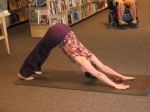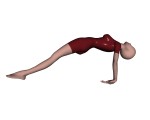 Happy new fitness year! Month? Week? Can you get to the gym at least once pretty soon and see what happens? In the year of 2012 I hope you’ll try your best to exercise and figure out how regular workouts can be a part of your life. I’ll admit it. Sometimes if I wasn’t the teacher, I’d just skip a day or two or three of exercising especially if I’m by myself. The tip about exercising in a herd or with a buddy really does help. But there is such a host of possible pitfalls when it comes to exercise that it’s no wonder people don’t stick to their New Year’s resolution to exercise more. Perhaps if you can be proactive and head off the troubles before they hit, you’ll stand a better chance of exercising longer and stronger.
Happy new fitness year! Month? Week? Can you get to the gym at least once pretty soon and see what happens? In the year of 2012 I hope you’ll try your best to exercise and figure out how regular workouts can be a part of your life. I’ll admit it. Sometimes if I wasn’t the teacher, I’d just skip a day or two or three of exercising especially if I’m by myself. The tip about exercising in a herd or with a buddy really does help. But there is such a host of possible pitfalls when it comes to exercise that it’s no wonder people don’t stick to their New Year’s resolution to exercise more. Perhaps if you can be proactive and head off the troubles before they hit, you’ll stand a better chance of exercising longer and stronger.
This list isn’t the typical “do this” and see if it helps list. It’s designed to prevent some potential problems that make exercise a chore or at least a bother.
1. No pain, no gain is the cruelest fitness cliché ever coined. Because it rhymes it has stuck in the exercise vernacular, but the idea does more harm than good. Bouncing while we stretch went out in the nineties with leg warmers and headbands. Pain is a signal that should alert you to an important message from your body. It’s your muscles and bones telling your brain to back off. “Ripping” muscle fiber to achieve a temporarily visual affect if not what is meant by health and fitness.
2. Timing is everything in the world of exercise. Your body loves consistency and your brain loves the high it gets from habit. Give them both a good reason to keep supporting you in everything you do by exercising as close to the same time on the same days as often as possible. This is the number one way to increase metabolism and speed up fat burning.
3. A good workout includes a warm-up period, an intense aerobic series, and a steady cool down. With practice or a good class with a competent instructor, you can learn to do this safely and efficiently in thirty minutes a day five times a week with a variety of different practices. Most people don’t exercise enough however and don’t get the cumulative benefits. Physical fitness is a lifestyle for the long haul. That way intensity can be safely implemented into a long term exercise plan. Think of your workout schedule like riding a roller coaster. Some workout days are more challenging than others. This actually provides muscles the work/rest time needed to develop safely.
4. If you’re talking too much while working out, you won’t be able to concentrate on the correct breathing. Breathing patterns can aid or detract from the value of an exercise. Muscles and the brain need oxygen and lots of it, especially during physical exertion. Learn how to breathe for the exercise program you’ve chosen. There are different philosophies in some fitness corners and they really do contribute to the overall benefit of the program. Focus on good breathing patterns when you exercise.
5. Unless you’re running a marathon, you can make it through a 55-minute exercise class WITHOUT taking a drink of water. Hydrate before and after because drinking water while you exercise draws blood and oxygen away from your muscles and to the stomach to deal with the fluids. You’ll make it.
6. As mentioned in #3, a balance of high intensity and gentle workouts aids the body in recovery and development. Try for three aerobic sessions per week and two or more lighter workouts in between.
7. Throwing money at exercise will not make your workouts any better. Low tech equipment such as light weights, good footwear, and a decent yoga mat are all just about anybody needs to accomplish a decent fitness plan. When money is involved, the brain starts thinking value and outcomes and ratios and “did I get my money’s worth?” Exercise doesn’t work that way. The value is experienced over time as health care costs are lower and self-esteem is higher. You can try, but placing a monetary label on something like positive mental health defeats the purpose in my opinion. A good instructor is worth her weight in chocolate, I mean calories, but be careful about obsessing over what it costs to be physically fit. The price of not being in good shape is the real number you should be worrying about.
Do you have any suggestions for things to avoid that have made your workouts better?
There are five primary areas of practice to the Writer Wellness plan. Every other week I will post an idea for relaxation (Monday Meditation,) creative play (Tuesday Tickle,) fitness and exercise (Wednesday Workout,) journaling and misc. (Thursday Thought,) and nutrition (Friday Feast.)
Meanwhile, remember to look for a digital or print copy of Writer Wellness, A Writer’s Path to Health and Creativity at Who Dares Wins Publishing, http://whodareswinspublishing.com.
And check out these great blogs for ideas to keep your writing and publishing healthy and prosperous.
http://writeitforward.wordpress.com/ Bob Mayer
http://jenniholbrooktalty.wordpress.com/ Jenni Holbrook
http://warriorwriters.wordpress.com/ Kristen Lamb
http://inspiration4writers.blogspot.com/ Inspiration for Writers, Inc.
http://pentopublish.blogspot.com/ Natalie Markey
http://amyshojai.com Amy Shojai
 Check out my new website Joy E. Held
Check out my new website Joy E. Held
Have you subscribed to this Writer Wellness blog yet? Get email updates when a new post is added. Click “subscribe” and leave your email. That’s it and thanks in advance!
Be well, write well






